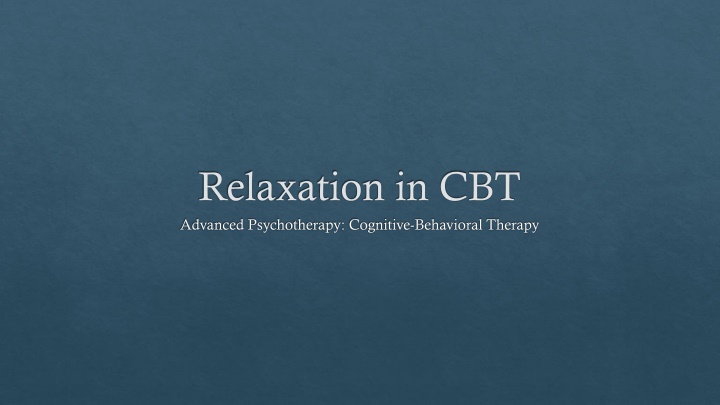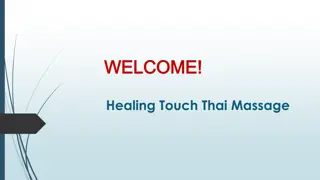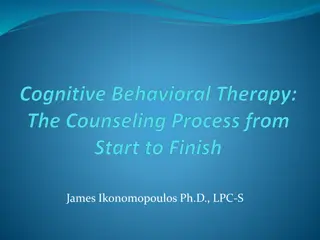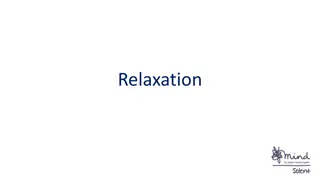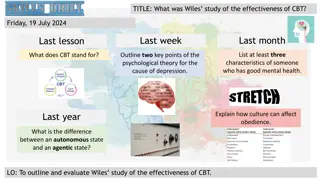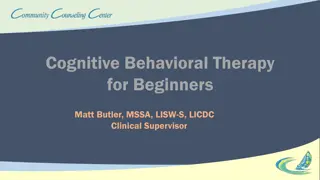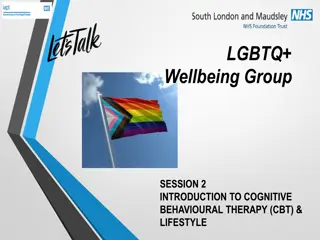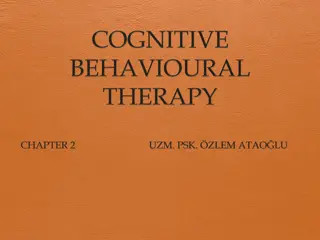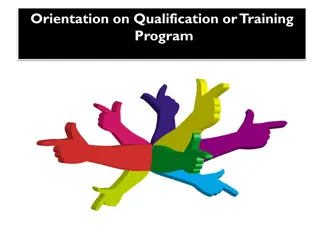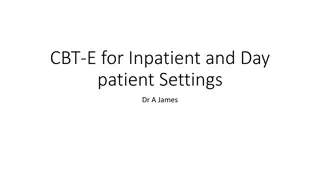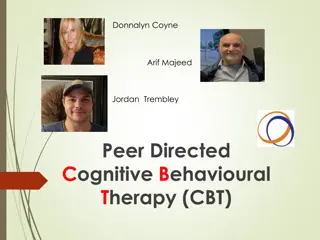Importance of Relaxation Techniques in CBT
"Exploring the significance of relaxation in Cognitive-Behavioral Therapy, this advanced psychotherapy delves into acquiring essential relaxation skills such as muscle relaxation, deep breathing, and imagery. Understanding and practicing these techniques can be transformative in managing stress, anxiety, and other mental health challenges."
Download Presentation

Please find below an Image/Link to download the presentation.
The content on the website is provided AS IS for your information and personal use only. It may not be sold, licensed, or shared on other websites without obtaining consent from the author.If you encounter any issues during the download, it is possible that the publisher has removed the file from their server.
You are allowed to download the files provided on this website for personal or commercial use, subject to the condition that they are used lawfully. All files are the property of their respective owners.
The content on the website is provided AS IS for your information and personal use only. It may not be sold, licensed, or shared on other websites without obtaining consent from the author.
E N D
Presentation Transcript
Relaxation in CBT Advanced Psychotherapy: Cognitive-Behavioral Therapy
Objectives To understand the concept and importance of relaxation in CBT To acquire specific relaxation skills (e.g., Muscle relaxation, deep breathing, imagery)
What are relaxation techniques? Relaxation techniques = techniques designed to reduce tension, stress, worry, and/or anxiety Vary in their focus (e.g., Physical sensations or changes in cognition/thoughts) and can be selected based on presenting difficulties, as well as patient preferences Some patients respond to physical procedures (e.g., Muscle relaxation and/or deep breathing), while others respond favorably to guided imagery
Why are relaxation skills important? Focus on skills that alleviate stress, anxiety, worry, and tension that are often debilitating and interfere with patient functioning Reducing distress increases positive treatment expectations and rapport Can discuss as method of increasing control (as opposed to direct discussion of mental health difficulties) helps with stigma Easy to teach and learn. Teach early in treatment to give patients an easy-to- learn, yet highly effective, skill set
Indications/Contraindications Broad applications: Daily relaxation exercises to reduce an overall sense of tension or stress not affiliated with any specific situation (e.g., General worry or apprehension) Specific applications: PTSD, specific phobia, social anxiety, or stressors at work Contraindication: Depressive symptoms occurring outside comorbid anxiety/worry Depressed patients generally lack energy and don t need additional relaxation
Tips Comfortable environment (e.g., Temperature, chair, noise) Sit comfortably (e.g., Uncrossing arms and legs, placing feet flat on the floor) Dim lights or remove bright sunshine from the room Having the patient close eyes (if comfortable enough) Bathroom break before starting if needed
Relaxation Exercises Progressive muscle relaxation Deep breathing Imagery
Progressive Muscle Relaxation Tense then relax muscle groups while paying close attention to the feelings associated with both tension and relaxation. Learn how to relax and recognize tension in the body to reduce its influence before each reaches high levels/impairment. First explain the reason for using muscle relaxation and how it will benefit the patient. Give full explanation and demonstration.
PMR Steps Step 1: Introduce PMR principles and procedures. Explain that creating relaxation begins by being able to identify and discriminate between sensations of tension and relaxation. Step 2: Inform the patient that sensations of tension and relaxation cannot occur at the same time. No muscles in the body can be tensed and relaxed at the same time.
PMR Steps Step #3: Identify states of tension. Explain that tension often builds gradually without conscious awareness. Detecting initial signs of an increase is an important step towards avoiding a full- blown occurrence of tension. No matter the level of intensity, can stop and reverse the tension using knowledge of PMR Over time patients become increasingly skilled at identifying stress earlier and earlier (e.g., Their awareness increases)
PMR Steps Step #4: Tense muscle groups Tense and release muscle groups in sequence: arms to the face, neck, chest and shoulders, torso, and legs. Try to tense only that muscle group during the tensing part of the exercise. Concentrate on the sensations produced by the different exercises. What are you noticing about your body right now? These questions help the patient to focus on the way the body feels when tense and relaxed.
Tensing Instructions Model each tension procedure. Dominant arm. Make a fist and tense biceps; pull wrist upward, while pushing elbow down against the arm of chair or bed. Nondominant arm. Same as above. Forehead, lower cheeks and jaw. Lift eyebrows as high as possible, bite teeth together, and pull corners of mouth tightly. Neck and throat. Pull chin down toward chest; tighten neck muscles. Shoulders, chest, and upper back/abdomen. Take a deep breath and hold it. Pull shoulder blades back and together. Make the stomach hard. Dominant leg. Lift foot off the floor and push down on the chair with thigh. Nondominant leg. Same as above.
PMR Steps Step 5: Debrief Discuss reaction to the muscle- relaxation exercise Monitor any pain the patient experienced to adapt and improve the technique for the individual patient s needs
PMR Steps Step 6: Continue to practice outside session Practice PMR at least once a day over the first week or two to build skills and confidence With practice can relax without having to actively tense the muscles Practice in quiet environment
Deep breathing Focuses on reducing rapid and shallow (ineffective) breathing that often occurs during periods of stress, worry, or anxiety Rapid and shallow breaths can lead to decreased oxygen in the system, which can cause hyperventilation, dizziness, lightheadedness, or decreased ability to concentrate Taking a deep, full breath can produce a feeling of calmness or slowing by increasing oxygen rich blood flow. Changing breathing results in feeling more relaxed in the body as well as the mind (feelings of calmness)
Deep Breathing Steps Step #1: Introduce deep breathing. Provide overview and describe potential benefits Step #2: Ask patient to put one hand on the abdomen (just above navel), one hand on the chest Step #3: Ask patient to pay attention to breathing and ask them to tell you which hand is doing more of the moving Deep breathing = hand on the abdomen moving, hand on chest still Step #4: Work with the patient to take deeper breaths by getting the hand over the stomach to move while having little movement of the hand over the chest Step #5: Ask the patient to continue slow, even, deep breaths Inhalations and exhalations = 3-5 seconds each
Deep Breathing Steps Step #6: Discuss changes in breathing and feelings of relaxation Step #7: Repeat exercise 3 or more times as needed Step #8: Discuss situations when deep breathing is appropriate Step #9: Continue practice outside of session. Homework = application of deep breathing to situations when the patient feels stress
Other Tips for Deep Breathing 1) Inhale through nose and out of mouth 2) Purse lips (as if blowing on hot soup) while exhaling 3) Close eyes during the exercise 4) Use mantra such as relax during each exhale 5) Pair deep breathing with imagery once skill developed 6) Deep breathing can be used in many situations and without notice of others
Imagery Imagery = nonphysiological (cognitive) relaxation technique to ease stress and promote an overall sense of well-being Focuses on increasing cognitive, emotional, and physical control by changing the focus of an individual s thoughts Imagery is highly effective for depression and anxiety, as well as specific situations that require clarity, focus, distraction, or feelings of mastery
Applications for Imagery Topic Focused topic Image Outcome Depression Negative self-worth Images of success or past success; images of pleasant past experience Increased self-confidence; reduced negative thoughts; distraction from negative mood Anxiety/worry Public speaking Image of speech that goes well; image of something funny Reduced negative focus; distraction; increased positive expectations Medical anxiety Fear of procedure (e.g., needles) Relaxation; peacefulness; pain free environment Less tension; reduced anxiety; toleration of procedure with less distress Sports performance Focused efforts during sports game (e.g., golf) Envisioning good shot; positive words of advice Increased focus; increased self-confidence; positive thinking
How Imagery Works Mind can actually affect how the body functions. Body responds same to an actual event and a thought Images that you are either somewhere else or in a different state of mind increase pleasant experiences and performance Helps to reduce stress tension and anxiety by changing thoughts and emotions or through distraction Guided imagery = process of strategically guiding the images the patient uses
Guided Imagery Steps Step #1: Introduce imagery Step #2: Identify the desired outcomes (e.g., decreased anxiety, distraction). Step #3: Develop an image or scene Work with patient to identify a situation that would produce desired outcome Could be real experience from the past or place would like to be (e.g., beach) Can use existing script Selection of powerful image is critical to the success of this technique. Selection of weak image (e.g., Not viewed as important by the patient or unable to be fully visualized) will likely lead to treatment failure
Guided Imagery Steps Continued Step #4: Increase vividness of the image Explore as many senses as possible to increase vividness of the image Ex: glass of lemonade, imagine holding a glass that feels icy and cold, visualize the color of the lemonade, think of the fresh citrus smell, and finally think of how the lemonade tastes The more details described by the patient, the more powerful the technique Step #5: Discuss impact of exercise on patient Step #6: Repeat until skills developed Step #7: Discuss situations to use imagery Step #8: Continue practice outside session Practice for homework and when feeling stressed
Additional Guided Imagery Tips Pair up imagery with deep-breathing exercises Ask patient to close eyes to increase vividness Prompt patient to think about sensory details to increase vividness Help the patient focus on aspects of the image that will guide him/her towards the goal Avoid too many unnecessary details that distract from goal Discuss that imagery is a portable skill Avoid imagery with psychotic patients
